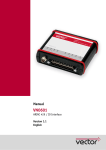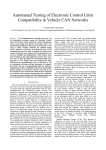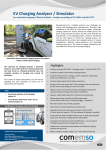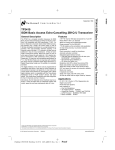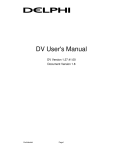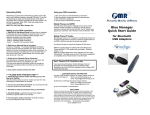Download PMTrac User Manual
Transcript
PMTrac® User Manual Revision 3.10 (9/17/14) PMTrac® User Manual EmiSense Technologies, LLC 1 of 26 Table of Contents 1.0 INTRODUCTION ..................................................................................................................................................... 4 2.0 PMTRAC SOFTWARE AND DOCUMENTATION INSTALLATION ................................................................................ 4 3.0 PM SENSOR MECHANICAL AND ELECTRICAL INSTALLATION................................................................................... 5 3.1 REQUIRED CABLES, ACCESSORIES AND DOCUMENTS ............................................................................................................. 5 3.2 PMTRAC SENSOR MECHANICAL INSTALLATION .................................................................................................................... 5 3.3 PMTRAC ELECTRICAL CONNECTIONS ................................................................................................................................. 6 3.4 CAN TERMINATION ....................................................................................................................................................... 7 4.0 BASIC OPERATION ................................................................................................................................................. 8 4.1 CAN ID CONFIGURATION................................................................................................................................................ 8 4.1.1 PMTrac Config Utility Operating Instructions .................................................................................................... 8 4.1.2 PMTrac Discovery Utility Operating Instructions ............................................................................................. 10 4.2 DATA LOGGING ........................................................................................................................................................... 11 4.2.1 PMTrac Logger Operating Instructions ............................................................................................................ 11 4.3 VECTOR CANALYZER DBC FILE........................................................................................................................................ 14 5.0 PMTRAC SENSOR OUTPUT ................................................................................................................................... 15 6.0 SPECIFICATIONS ................................................................................................................................................... 16 7.0 TROUBLESHOOTING............................................................................................................................................. 17 8.0 WARNINGS AND PRECAUTIONS ........................................................................................................................... 17 APPENDIX A: PMTRAC CAN COMMUNICATION PROTOCOL VERSION 3.0 .................................................................. 19 A.1 OVERVIEW ................................................................................................................................................................. 19 A.2 COMMAND MESSAGES ................................................................................................................................................. 21 A.3 AVAILABLE COMMANDS ................................................................................................................................................ 22 A.4 CURRENT DATA MESSAGE .............................................................................................................................................. 24 A.5 HEATER DATA MESSAGE ................................................................................................................................................ 25 A.6 DISCOVERY MESSAGES ................................................................................................................................................. 26 PMTrac® User Manual EmiSense Technologies, LLC 2 of 26 List of Figures Figure 1. Typical PMTrac Sensor Installation in Exhaust Pipe ...........................................................................5 Figure 2. Connect Sensor Leads and BNC Connector to Electronics Module. No heater version on the right. 6 Figure 3. PMTrac Electrical Connections ...........................................................................................................7 Figure 4. PMTrac Config Screen after Changing Command, Current, and Heater IDs from Default Values ....9 Figure 5. PMTrac Discovery Screen After Finding Command, Current Data, and Heater Data IDs ................10 Figure 6. PMTrac Logger with 3 Sensors Present ...........................................................................................13 Figure 7. PMTrac Logger with 3 Sensors with HV Off/on and after Introduction of Soot .................................14 Figure 8. PMTrac Sensor Demonstrates Good Linearity with PM Concentration at Constant EGV and EGT 15 PMTrac® User Manual EmiSense Technologies, LLC 3 of 26 1.0 Introduction The PMTrac® PM sensor was developed for measuring particulate matter (PM), or soot, concentrations in diesel or gasoline exhaust by EmiSense Technologies, LLC. Please review this manual and the warning and caution statements before using the PMTrac system. This user manual covers the: 1) software installation; 2) mechanical installation of sensors in the exhaust pipe; 3) electrical connections between the sensor, electronics module, and CAN bus; 4) PMTrac signal output and 5) troubleshooting. 2.0 PMTrac Software and Documentation Installation Download the PMTrac installer from our website: http://emisense.com/pmtrac-downloads/ Run the PMTrac installer on a Windows PC (Windows 7 or newer) and follow the step by step instructions. It will install the following: PMTrac Manual (this document) Utilities to configure PMTrac hardware A sample PMTrac data logger LabView source for the above logger and utilities A Vector Canalyzer DBC file Data analysis spreadsheets referred to in this manual Note: The installer will also install the National Instrument LabView Run-Time environment and National Instrument NI-CAN USB CAN Interface drivers on your machine. PMTrac® User Manual EmiSense Technologies, LLC 4 of 26 3.0 PM Sensor Mechanical and Electrical Installation 3.1 Required Cables, Accessories and Documents The following cables, accessories, and documents are useful to setup and operate the EmiSense PMTrac® sensor: 1. 2. 3. 4. 5. 6. 7. PMTrac sensor and electronics module USB CAN interface (NI USB-8473) Standard DB-9 serial cable (Female-Female, 6 feet) for CAN communication PMTrac® user manual PMTrac installer file Banana cables for power (not provided) 12.5-15.5V DC Power supply (not provided) 3.2 PMTrac Sensor Mechanical Installation Install the sensor in exhaust pipe with lead wires not connected to the electronics module. The threads on the sensor are M18-1.5. A small amount of anti-seize applied to the sensor housing threads, not the bung, is recommended. The sensor housing inlet holes should be kept free of anti-seize. Figure 1 shows details of a typical installation in an exhaust pipe, including acceptable angular position. Figure 1. Typical PMTrac Sensor Installation in Exhaust Pipe PMTrac® User Manual EmiSense Technologies, LLC 5 of 26 3.3 PMTrac Electrical Connections With the power off the sensor is connected to the electronics module as shown in Figure 2. Connect the blue banana jack from the sensor to the blue banana socket (marked Hgnd) on the electronics box. The yellow banana jack (heated sensor versions only) is connected to the yellow banana socket (marked Heater) on the electronics box. Connect the coax BNC connector from the sensor to the BNC connector on the electronics box. Figure 2. Connect Sensor Leads and BNC Connector to Electronics Module. No heater version on the right. The electronics module is powered by connecting 12.5-15.5V DC to the input banana jacks labeled Power, located on the front of the electronics box. Connect low, or ground to the black banana jack and high to the red banana jack. Once power is connected, the LED on the front of the electronics module should light up. When a test is completed, power off the unit by disconnecting the power to the electronics module. The electronics module communicates with a host controller via a male DB9 CAN connector mounted on the front panel. Figure 3 shows a PMTrac electronics module connected to a sensor and a National Instruments USB-8473 CAN interface and a laptop computer. When a module is powered on and communicating with a host, it should start broadcasting data messages at 1 Hz. When the module sends a CAN message, the LED will turn off for a few milliseconds. A blinking LED indicates communication with the controller. The electrode high voltage (HV) is not turned on until the module receives the appropriate command from the controller. Details about the command and data messages are found in Appendix A of this document. PMTrac® User Manual EmiSense Technologies, LLC 6 of 26 Figure 3. PMTrac Electrical Connections 3.4 CAN Termination The electronics module has a built-in termination resistor for the CAN bus. If multiple electronics modules are connected to the CAN bus, only one electronics module needs to be terminated. The built-in termination resistor can be switched off with a switch located between the LED and the CAN DB9 connector. The switch lever can be moved with the tip of a pen. If the switch is in its DOWN position, the internal termination resistor is connected to the CAN bus. If the switch is in its UP position the internal termination resistor is disconnected from the CAN bus. PMTrac® User Manual EmiSense Technologies, LLC 7 of 26 4.0 Basic Operation Up to eight PMTrac systems can be operated and monitored simultaneously using the PMTrac Logger and a National Instruments USB-8473 CAN interface. Alternatively, the modules can be operated and monitored using appropriate software and hardware from vendors such as Vector, Kvaser, and others. The basic steps of the PMTrac system operation are as follows: 1. 2. 3. 4. 5. 6. 7. 8. Mechanical installation Electrical connections Power on electronics module Verify communication Change data reporting rate if needed (default is 1 Hz) Once exhaust gas dew point is exceeded, turn on the HV electrode Turn on heater monitoring (recommended, heater version only) Power off electrical module once test is completed The rest of this section provides instructs on operation of the PMTrac configuration utilities and logger included in the installer. 4.1 CAN ID Configuration If more than one module is to be operated on the same CAN bus, each must have unique message IDs. Typically sensors are shipped from EmiSense with the following standard message IDs: Command ID = 100 Current Data ID = 110 Heater Data ID = 120 If shipped with different message ID’s the message ID’s as shipped will be listed on the label the top of the electronics module. The PMTrac Config utility is used to change the message IDs. 4.1.1 PMTrac Config Utility Operating Instructions 1. Connections and Communication a. b. c. d. Power on the PMTrac electronics module Connect NI USB-8473 to the electronics module and to your PC Run the PMTrac Config utility Verify CAN communication i. Select CAN interface (0 is default) ii. CAN indicator will illuminate bright green when CAN communication is established PMTrac® User Manual EmiSense Technologies, LLC 8 of 26 2. Changing IDs a. Enter the Command ID of the target module i. Select standard (Std) or extended (Ext) ID b. Enter the new IDs i. Select standard (Std) or extended (Ext) ID’s c. Select Change IDs i. It should illuminate bright green momentarily ii. The IDs will be changed to the New IDs that were entered 3. Exit the program by selecting Exit Figure 4 shows an example. Figure 4. PMTrac Config Screen after Changing Command, Current, and Heater IDs from Default Values PMTrac® User Manual EmiSense Technologies, LLC 9 of 26 If the message IDs of a module are not known, they can be determined using the PMTrac Discovery utility. This utility is to be used only when a single PMTrac module is connected to the CAN bus. 4.1.2 PMTrac Discovery Utility Operating Instructions 1. Connections and Communication a. Power on the PMTrac electronics module i. Make sure only one PMTrac module is connected to CAN bus b. Connect NI USB-8473 to the electronics module and to your PC c. Run the PMTrac Discovery utility d. Verify CAN communication i. Select CAN interface (0 is default) ii. CAN LED will illuminate bright green when CAN communication is established 2. Finding IDs a. Select any one of the 3 IDs from the ID to find list i. Select Find ID 1. When the ID is found, the ID Found? LED will illuminate bright green momentarily 2. The appropriate ID box on the right side of the screen will populate with the ID a. If the ID is extended, XTND will appear after the ID, for example : 100 XTND b. Repeat for the other 2 IDs 3. Exit the program by selecting Exit Figure 5 shows an example for a module with the default IDs. Figure 5. PMTrac Discovery Screen After Finding Command, Current Data, and Heater Data IDs PMTrac® User Manual EmiSense Technologies, LLC 10 of 26 4.2 Data Logging Up to eight PMTrac systems can be operated and monitored simultaneously using the PMTrac Logger and a National Instruments USB-8473 CAN interface. The Logger can be used to send commands to the electronics modules, log the sensor HV, current and heater data and view the current data graphically. 4.2.1 PMTrac Logger Operating Instructions 1. Connections and Communication a. b. c. d. Connect all PMTrac systems to be tested to the CAN bus Connect NI USB-8473 to the CAN bus and to your PC Run the PMTrac Logger Verify CAN communication i. Select CAN interface (0 is default) ii. CAN LED will illuminate bright green when CAN communication is established 2. Configuration a. Enter the appropriate message IDs, sensor IDs and electronics IDs (optional) into the Sensor ID Table i. If the IDs are extended, enter yes or Yes into the XTND field ii. Each time the logger is started, the latest saved table will be loaded 1. The table is saved each time data logging is started and on exit of the program iii. The table cannot be edited while data logging is on b. Once the PMTrac modules are powered, the Present LED for each module should illuminate bright green c. Enter the log file name into the Log File Name field i. The date will be added to the log file name ii. The date format is ddmmyy d. The log file will be stored in the folder indicated in the Log File Path field PMTrac® User Manual EmiSense Technologies, LLC 11 of 26 3. Data Logging a. Select Start Logging to create a log file and plot the PMTrac sensor current vs. time i. The Data Logging LED will light bright green ii. A log file with the name you entered will be created 1. Data from each module present will be logged to the file iii. Sensor current vs. time will be displayed on the graph b. To stop logging, select Start Logging again 4. Controlling the Modules a. The following settings can be set for the modules: i. HV on/off ii. Heater logging on/off (heated sensor versions only) iii. Data reporting rate 1Hz/10Hz (applies to all modules present) 1. Heater data is always reported at 1Hz b. Within the box labeled Control, select HV and Log Htr for each module as desired i. Bright green indicates on c. Set the data reporting rate with the 1Hz/10Hz toggle switch d. Select Update Settings i. The settings for each module present will be updated 5. Viewing the Status a. The following status indicators can be viewed for each module anytime CAN communication is established: i. Present (data messages are being received) ii. HV stat (HV status) iii. Log Htr (heater logging on/off) iv. Last nA (value of the last sensor current data received, in nA) b. Present and Log Htr status indicators are bright green when on i. Because heater reporting is always at 1 Hz, the Log Htr LEDs will flash when data reporting is set to 10 Hz PMTrac® User Manual EmiSense Technologies, LLC 12 of 26 c. HV stat has multiple states i. Blue – on at normal levels ii. Yellow – on but low iii. Red – on but very low 1. A persistent red status may indicate a short in the sensor or an issue with the electronics module iv. Black – HV off 6. Viewing the Current Data Graphically a. When data logging is on, the sensor current for each PMTrac system present is displayed on the graph i. The y-axis is current in nA ii. The x-axis is elapsed time in seconds b. Each plot can be turned on/off by selecting the appropriate plot in the legend to the left of the graph 7. Exit the program by selecting Exit Figure 6 shows an example with 3 sensors present and data logging not started. Figure 7 shows the same setup after starting data logging, turning HV and Htr monitoring on and adding soot to the exhaust pipe. Figure 6. PMTrac Logger with 3 Sensors Present PMTrac® User Manual EmiSense Technologies, LLC 13 of 26 HV On ~ 5 mg/m3 Soot HV Off No Soot HV On No Soot Figure 7. PMTrac Logger with 3 Sensors with HV Off/on and after Introduction of Soot 4.3 Vector Canalyzer DBC File The PMTrac Logger and utilities with NI USB-8473 provide a turnkey solution for PMTrac system operation. A DBC file created with the Vector CANdb++ Editor is also provided for those users that prefer to communicate with the PMTrac sensors using Vector CANalyzer or similar software. PMTrac® User Manual EmiSense Technologies, LLC 14 of 26 5.0 PMTrac Sensor Output As you can see in the chart below (figure 8) PMTrac sensors have a good statistical correlation to soot concentration. Typically on the order of 4nA per 1 mg/m3. Jing Mini-CAST 1 Constant EGT = 24 oC 1 LPM sample flow Constant EGV ~ 30 m/s 1 each PMTrac Sensor Figure 8. PMTrac Sensor Demonstrates Good Linearity with PM Concentration at Constant EGV and EGT However the exact correlation will vary based on a number of factors, such as particle charge distribution, particle size distribution, and so on. So a sensor must be calibrated to your particular application. Normally this involves logging data from the system in operation and then analyzing the results. For additional assistance on using PMTrac technology effectively for your application contact us at [email protected]. PMTrac® User Manual EmiSense Technologies, LLC 15 of 26 6.0 Specifications Table 1. PMTrac Specifications Item Electronics box Input power CAN Communications baud rate Operation concentration Range Housing threads (M18x1.5) Supply current PMTrac® User Manual Low High 12.5 VDC 15.5 VDC NA 500 kbit/s 0 mg/m3 600 mg/m3 Comment 14V recommended for best results Fixed at 500 Kbit/s Range may vary with engine and operating conditions 45 N-m ( 33 lbs-ft) 6 Amperes/sensor During normal operation, steady state current should be 30 to 50 mA. Current is significantly higher momentarily on startup, during heater operation and for very short periods during normal operation. EmiSense Technologies, LLC 16 of 26 7.0 Troubleshooting You have received an EmiSense PMTrac® PM sensor(s) and electronic module(s). Table 2 is a troubleshooting guide. All technical operational and troubleshooting questions should be directed to [email protected]. Table 2. PMTrac Troubleshooting Guide Symptom Reported high voltage is low and output appears normal Possible Cause Excessive soot fouling Reported high voltage is low and output excessively high Soot bridge between electrode and sensor body Non-zero baseline at EGT > 100C (output at zero or near zero PM) Excessive soot fouling Non-zero baseline at EGT < 100C (output at zero or near zero PM) No response Water condensation No response Sensor not properly connected Electronics not properly powered Sensor damaged No response Electronics damaged No response Recommended Action Blow compressed air through sensor holding compressed air nozzle ~ 1 to 2 inches from sensor tip Blow compressed air through sensor holding compressed air nozzle ~ 1 to 2 inches from sensor tip Blow compressed air through sensor holding compressed air nozzle ~ 1 to 2 inches from sensor tip Wait until EGT exceeds dewpoint Check all connections Check input power to electronics Return sensor and electronics module to EmiSense Return sensor and electronics module to EmiSense 8.0 Warnings and Precautions 1. It is recommended to use minimal amounts of anti-seize and to apply it to the sensor’s threads rather than the bung when installing our sensor in an exhaust pipe so that the sensor’s intake holes don’t get plugged with excessive anti-seize. 2. Do not exceed the maximum installation torque of 45 N-m ( 33 lbs-ft) to avoid any accidental damage to the threads/galling upon removal 3. It is required to wait until the gas temperature exceeds the dewpoint of the exhaust before powering up the sensor to avoid erroneous readings. 4. It is important to connect the all leads to the electronics module when operating the sensor. 5. This device operates at a high voltage. There is a possible risk of fire and/or electric shock. 6. Ensure all warning, cautions, and instructions for use are read and understood prior to using the PMTrac® PM Sensor Device. PMTrac® User Manual EmiSense Technologies, LLC 17 of 26 9.0 REVISION HISTORY Revision 3.10 Date 9/17/14 3.09 3.08 9/18/13 8/9/13 3.07 3.06 3.05 3.04 3.03 3.02 3.01 3.00 2.0 (aka “B”) 1.0 3/28/13 11/30/12 11/29/12 10/24/12 8/15/12 8/15/12 8/14/12 8/14/12 10/5/2011 6/13/11 PMTrac® User Manual Comments Removed obsolete sections, notes for no heater sensors Updated for 3.0 firmware and LabView VI Updated for revised Venturi and improved input protection. Removed autozap feature and heater regeneration references. Corrected default settings (raw current, HV) Corrected various typographical errors. Update default settings and grounding info. Version for SwRI testing Corrected various typographical errors. Updated figures. Updated B2-specific instructions. Initial Draft supporting ‘B2’ sensors Supporting ‘B1’ sensors Supporting ‘A2” sensors EmiSense Technologies, LLC 18 of 26 APPENDIX A: PMTrac CAN Communication Protocol version 3.0 Data Rate: 500kbps (fixed) Message length: All messages are 8 bytes (CAN dlc=8) in length Byte order: Most significant byte first bBig endian) Readiness after power on: The PMTrac sensor electronics are ready to receive commands no later than 2 seconds after power up CAN Bus timing spec: ISO 15765 Message IDs: Programmable, extended and standard IDs supported Default IDs: Command ID: Standard ID of value 100h Current Data ID: Standard ID of value 110h Heater Data ID: Standard ID of value 120h A.1 Overview In normal operation PMTrac uses three basic message types. Each basic message type has its own dedicated message ID: Command messages are sent by host control systems to the Command ID to issue commands to the PMTrac electronics Current data messages are periodically sent by the PMTrac electronics to the Current Data ID Heater data messages are periodically sent by the PMTrac electronics to the Heater Data ID (when enabled) The current data messages contain both the primary measurement (soot current) and basic system status. PMTrac® User Manual EmiSense Technologies, LLC 19 of 26 CAN communication exchanges used in typical operation: Host PMTrac Power Applied 1st Current Data message received, indicating that the unit is active and ready to receive commands Send Command message to Command ID, enabling heater measurements Current Data messages sent to Current Data ID at 1 Hz (default rate) Current Data & Heater Data messages sent to Current Data ID & Heater Data ID at 1 Hz Determine that the operating environment is suitable for high voltage operation Send Command message to Command ID, enabling high voltage Status information in Current Data messages changes to indicate that high voltage is present Record and/or use the PMTrac soot current measurements * Optional Flowchart of CAN Communication in Typical PMTrac Operation Please note that the optional heater related steps above do not heat the sensor. Heater measurements are small bursts of heater operation that provide voltage and current information. These measurements, in turn, can be used to calculate heater resistance, which is an indirect indication of sensor temperature. PMTrac® User Manual EmiSense Technologies, LLC 20 of 26 A.2 Command Messages A host (ECU, data acquisition system) sends command messages to the Command ID to control the PMTrac electronics. Command messages are 8 Bytes long and have the following format: Msg ID Byte# Command 1 Msg ID CMD 2 3 Parameters 4 5 6 7 RSVD 8 CSUM CMD is the command ID. Parameters are optional parameters that go with the selected command. If a parameter byte is unused it should be set to 00h. RSVD is a reserved byte and must be 00h. CSUM is an inverted checksum of CAN payload byte 1 (CMD) through CAN payload byte 7 (RSVD). The CAN protocol already includes basic packet error checking but this additional checking is used to prevent accidental activation of the 1000V or reprogramming of the configuration. CSUM Example: CMD = 10h (high voltage control) First parameter byte = 01h (high voltage on) Remaining parameter bytes = 00h 00h 00h 00h RSVD = 00h To calculate CSUM start byte adding the 7 bytes (maintaining an 1 byte result): 10h + 01h + 00h + 00h + 00h + 00h + 00h = 11h Then invert the result: 11h XOR FFh = EEh CSUM = EEh for this command. PMTrac® User Manual EmiSense Technologies, LLC 21 of 26 A.3 Available Commands The following CMD values are supported: CMD Value 10h 11h 12h A0h Function High Voltage Control Heater Measurement Control Set Reporting Rate Configure CAN ID High Voltage Control (10h) This command is used to turn the 1000V high voltage supply on and off. BYTE CMD Param1 Param2 Param3 Param4 Param5 Value 10h State 00h 00h 00h 00h Description High Voltage Control Command 00h = 1000V off, 01h = 1000V on Default state is 1000V OFF. Heater Measurement Control (11h) The PMTrac electronics can periodically pulse the sensor heater on and off and measure the resulting current and voltage. From this, heater resistance can be calculated, giving an indirect indicator of sensor temperature at the heating element. BYTE CMD Param1 Param2 Param3 Param4 Param5 Value 11h State 00h 00h 00h 00h Description Heater Measurement Control Command 00h = measurement off, 01h = measurement on Default state is heater measurement OFF. PMTrac® User Manual EmiSense Technologies, LLC 22 of 26 Set Reporting Rate (12h) While power is applied the PMTrac electronics periodically broadcast a Current Measurement message. The rate at which this message is reported can be configured using this command. BYTE CMD Param1 Param2 Param3 Param4 Param5 Value 12h Rate 00h 00h 00h 00h Description Set Reporting Rate Command 00h = 1 Hz, 01 = 10 Hz Default rate is 1 Hz. Configure CAN ID (A0h) The PMTrac electronics uses up to 3 CAN IDs. The IDs can be configured with this message. BYTE CMD Param1 Value A0 ID_TYPE Param2 Param3 Param4 Param5 NEW_ID Description Configure CAN ID Command Bits 4-7 specify the ID to change, bit 0 = 0 for STD, 1 for Extended ID 00h = Set Std command ID, 01h = Set Ext. command ID 10h = Set Std current ID, 11h = Set Ext. current ID 20h = Set Std heater ID, 21h = Set Ext. heater ID New ID as unsigned, 32 bit number (big endian) Default IDs are Command = 100h, Current = 110h, Heater = 120h IMPORTANT NOTE: Configure CAN ID command messages are a special case. Other commands can be sent as fast as the CAN bus can accept them, but CAN IDs are recorded in flash memory (so they persist between power cycles). When sending this command host controllers should either wait 500 mS (.5 seconds), or listen for the next current data message transmitted by the PMTrac electronics before sending any subsequent commands. PMTrac® User Manual EmiSense Technologies, LLC 23 of 26 A.4 Current data message Current data messages are sent continuously when power is applied to the PMTrac electronics. The rate can be set to 1 Hz or 10 Hz (default is 1 Hz). Current data messages also include basic status information and receiving them is an indication that the PMTrac electronics are ready to accept commands. Msg ID Current msg ID Byte # 1 Flags 2 3 Particle current 4 5 6 HV value 7 8 FW Version The fields in this message have the following usage Flags Byte The bits on the Flags Byte have the following meaning (where bit 0 is the least significant bit): Bit # 7 6 5-1 0 Meaning High Voltage Heater Measurement Reserved Current Reporting Rate Values 0=off, 1=on 0=off, 1=on 0 0=1Hz, 1=10Hz Particle current The average particle current over the selected reporting period (1 Hz or 10 Hz). The value is an unsigned 32 bit integer, indicating pico amps, stored in big endian. HV value This is the High Voltage primary side (indirect) monitor reading. It is reported directly in ADC counts (12 bit ADC reading, reported as unsigned 16 bit integer, stored in big endian). The current version of PMTrac electronics starts with a 27 volt signal, through a 34:1 divider, then measure in 1 mV steps. So the expected signal is approximation 800 max (‘1000V’) down to 0 (‘0V’). FW Version Bit # 4-7 0-3 Meaning Major Version Minor Version PMTrac® User Manual Possible Values 0-15 0-15 EmiSense Technologies, LLC 24 of 26 A.5 Heater data message Heater data messages are sent after heater measurement is turned on using a command message (see above). The update rate is fixed at 1 Hz. Msg ID Htr data msg ID Byte # 1 2 Hoff voltage 3 4 Hon voltage 5 6 Heater current 7 Reserved 8 The fields in this message have the following usage: Hoff voltage The voltage measured across the heater while it is unpowered. This value is reported in mV, 16 bit unsigned integer, big endian. Hon voltage The voltage measured across the heater while it is very briefly pulsed on. This value is reported in mV, 16 bit unsigned integer, big endian. Heater current The current measured through the heater during the Hon period. Hon Voltage / Heater current represents heater resistance at this time. This value is reported in mA, 16 bit unsigned integer, big endian. PMTrac® User Manual EmiSense Technologies, LLC 25 of 26 A.6 Discovery Messages The following messages are intended to be used only when a single PMTrac electronics box is isolated on a dedicated CAN bus. They allow the unit’s current CAN ID settings to be recovered. Both messages are similar to a standard command message, but are sent to dedicated CAN IDs. Msg ID Byte# Ext. 1 0xA5A5A5 CMD 2 3 Parameters 4 5 6 7 RSVD 8 CSUM Discover ID Command (B0h) This message is broadcast to discover a CAN ID from the PM Trac electronics. It ONLY works when broadcast to the extended CAN ID above. BYTE CMD Param1 Param2 Param3 Param4 Param5 Value B0 ID DEh ADh BEh EFh Description Discover ID Command 00h = Command, 10h = Current, 20h = Heater Magic Word Discover ID Response (B1h) This message is broadcast by PMTrac hardware in response to a Discover ID message (see above). BYTE CMD Param1 Value B1 ID_EXT Param2 Param3 Param4 Param5 ID PMTrac® User Manual Description Discover ID Response Bits 7-4 designate ID being provided, bit 0 indicates if ID is extended mode 00h = Command Std, 01h = Command Ext 10h = Current Std, 11h = Current Ext 20h = Heater Std, 21h = Heater Ext The CAN identifier as a 32 bit, unsigned integer (big Endian) EmiSense Technologies, LLC 26 of 26



























